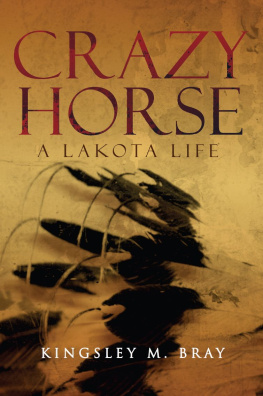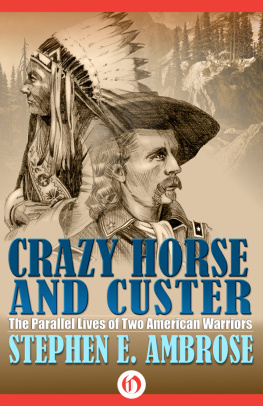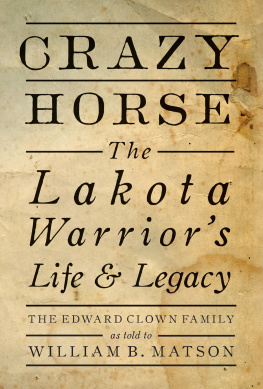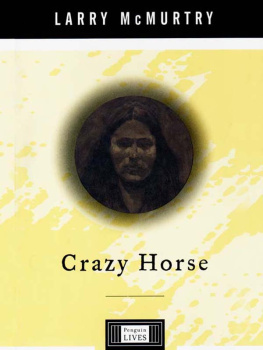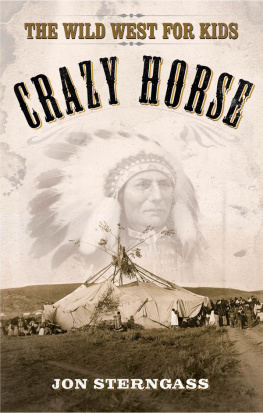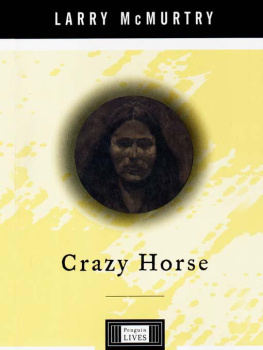Crazy Horse
A Lakota Life
K INGSLEY M. B RAY
University of Oklahoma Press : Norman

2800 Venture Drive
Norman, Oklahoma 73069
www.oupress.com
Copyright 2006 by the University of Oklahoma Press, Norman, Publishing
Division of the University. Manufactured in the U.S.A.
All rights reserved. No part of this publication may be reproduced, stored in a retrieval system, or transmitted, in any form or by any means, electronic, mechanical, photocopying, recording, or otherwiseexcept as permitted under Section 107 or 108 of the United States Copyright Actwithout the prior permission of the University of Oklahoma Press.
For information about permission to reproduce selections from this book, write to Permissions, University of Oklahoma Press, 2800 Venture Drive, Norman, Oklahoma 73069 or email rights. oupress@ou.edu
ISBN 978-0-8061-8375-6 (eBook-mobipocket)
ISBN 978-0-8061-8376-3 (eBook-epub)
Crazy Horse: A Lakota Life is Volume 254 of The Civilization of the American Indian Series.
This eBook was converted from the original source file by a third-party vendor. Readers who notice any formatting, textual, or readability issues are encouraged to contact the publisher at oupressproduction@ou.edu .
For my mother and father,
Christine Mary and James David Francis Bray
CONTENTS
ILLUSTRATIONS
F IGURES
Following
M APS
ACKNOWLEDGMENTS
It is a special pleasure to acknowledge the assistance of many members of the Lakota community in North and South Dakota. Several informants requested anonymity, especially in the sensitive matters of Crazy Horses family life. Many made available private family documents; all have contributed to the deeper background of Crazy Horse: A Lakota Life. Especially significant interviews were conducted with the following Lakota people, whose contribution is gratefully acknowledged:
LaDonna Brave Bull Allard, Fort Yates
Emma Chase Alone West, Manderson
Elsie Clown, Eagle Butte
Victor Douville, Sinte Gleska University, Mission
Mario Gonzalez, Black Hawk
Ellen in the Woods, Eagle Butte
Leonard Little Finger, Loneman School, Oglala
Loretta Little Hawk, Pine Ridge
Elaine Quick Bear Quiver, Pine Ridge
Chris and Nita Ravenshead, Custer
Lula Red Cloud and Harry Burk, Hermosa
Evangeline Lucille Runs After, Rapid City
Donovin Sprague, Historian, Crazy Horse Memorial, Crazy Horse Mountain
Alex White Plume, Manderson
Harvey White Woman, Kyle
Jack Meister, of Waleska, Georgia, gave crucial assistance in the interview process. Jack indefatigably tracked down individuals, made calls, and put me in touch with informants. I look forward to more years of cooperation in discovering the Lakota past.
In England, fellow students of the Plains Indians helped at various stages in the process of research and writing. Neil Gilbert, English Westerners Society, helped crystallize my ideas about the Battle of the Rosebud. Members of the Custer Association of Great Britain, especially Derek Batten, Francis Taunton, and Barry C. Johnson, in inviting me to speak on Crazy Horse, helped me focus my concept of the Battle of the Little Bighorn. Thanks are also due to Barry for his long loan of the Eli S. Ricker Papers microfilm. In many hours of debate in person and on the telephone, I derived knowledge and wisdom from my dear late friend Colin Taylor, dean of American Indian studies.
I owe a special debt to Joseph Balmer, of Erlenbach, Switzerland. A founding member of the English Westerners Society, Joe was also a prolific correspondent with historians and Indian people. His gift of a large collection of George E. Hydes research papers helped focus my historical ambitions, and his loans of his extensive correspondence with such reservation contacts as John Colhoff and Eddie Herman are resources that I still consult daily. Without Joes belief and contribution, this book would be the poorer.
In the United States, the staffs of a number of institutions have been of material assistance. Thanks are due to Barbara Larsen, National ArchivesCentral Plains Region, Kansas City, Missouri; Michael Musick and Robert E. Kvasnicka, National Archives, Washington, D.C.; Dayton W. Canaday, former director, South Dakota Historical Society. Fellow Indian Wars historians Paul L. Hedren and Jerome A. Greene have helped with encouragement and information. Throughout twenty years of my research, the Nebraska State Historical Society has been an incomparable resource and source of material aid. Through Director Lawrence J. Sommer, the society helped underwrite the costs of research trips. Nebraska Game and Parks Commission helped make accommodations available for my family and me. At the University of Oklahoma Press, I owe thanks to editor-in-chief Charles E. Rankin, acquisitions editor Alessandra E. Jacobi, and manuscript editor Steven B. Baker for bringing this book to fruition. Copyeditor Melanie Mallon helped make the final cuts with enviable grace and meticulous attention to detail.
Colleagues have generously shared knowledge, views, and facts. In particular, I thank Raymond J. DeMallie, Department of Anthropology, University of Indiana, Bloomington; Mike Cowdrey, San Luis Obispo; and Ephriam D. Dickson III, Salt Lake City.
A cluster of friends and their families have been vital contributors to this book and my continuing research into the history of the Lakota people and the Native plains. Nebraska History editor Donald B. Cunningham was a gracious host and guide on a memorable trip across the plainsheres hoping for many more! At the Fort Robinson Museum, curator Thomas R. Buecker has been a source of fact, food, and good humor. R. Eli Paul, museum director of the Liberty Memorial Museum of World War One, Kansas City, Missouri, has been generous in sharing documents, views, and knowledge. Gail DeBuse Potter, director of the Museum of the Fur Trade, Chadron, Nebraska, is a constant source of logistical aid and good grace in my trips to the plains. As if that were not enough, she is married to James E. Potter, retired now as editor of Nebraska History, who has facilitated research and dispensed wit and wisdom in equal measure. Last but not least, James A. Hanson, editor, Museum of the Fur Trade Quarterly, who first invited me to the plains, showed me Fort Laramie, the Powder River country, and one imperishable Wyoming morning, the sunrise over Pumpkin Buttes; he has been for more than twenty years the Prince of Companions.
Finally, no thanks could be complete without acknowledging my family. My father first encouraged my childhood interest in the American West by bringing home from our public library in Yorkshire works by Francis Parkman, Mari Sandoz, and George Hyde. His and my mothers belief in this project is reflected in the dedication. My wife, Annlodestone, anchor, and North Starhas been a sounding board for ideas and an indispensable partner in all enterprises. Without her presence, I could not have completed this book. Our children, Ciana, Dubheasa, and David, in not letting me escape from the joyous toils of family life, have contributed more than they can know to my understanding of life in Lakota lodges.
INTRODUCTION
Crazy Horse was the greatest war leader of the Lakota people. Acknowledged by tribal foes as the enemy they most feared, honored by allied tribesmen as the bravest of all warriors, Crazy Horse counted more than two hundred coups, a war record unmatched by any of his peersRed Cloud, Spotted Tail, Sitting Bull, or any of that remarkable cohort of Lakota leaders growing up during the first half of the nineteenth century. His inspirational courage was a byword, matched by a generosity that won the praise of all his people. Had he been born into an earlier century, his achievements would have been tallied only in the winter counts, the pictographic calendars that recorded Lakota history. Instead, Crazy Horse was born in 1840, just as the presence of Euro-Americans on the Great Plains shifted gears from sporadic trade to a juggernaut of expansion. The Manifest Destiny that transformed the American West from tribal hunting grounds to the agricultural and industrial heartland of modern America provoked inevitable resistance from the Plains Indians.
Next page
